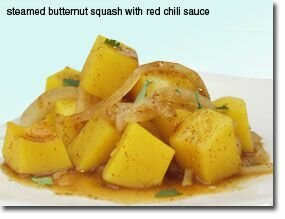healthy food tip and recipe
Today's Recipe
If you don't know what to serve for dinner tonight ...
The beautiful orange color of the squash reflects its rich concentration of health-promoting beta carotene. Combine the nutritional value of the squash with the great taste of the red chili sauce for a great addition to your Healthiest Way of Eating.

Ingredients:
- 1 medium-sized butternut squash, cut into 1-inch cubes (about 4 cups)
- 1 medium onion, cut in half and sliced
- 3 cloves garlic, chopped
- 1 tsp red chili powder
- 1/8 tsp ground cumin
- 1/8 tsp cinnamon
- 1 TBS + 1 cup chicken or vegetable broth
- salt and black pepper to taste
- 1 TBS chopped cilantro
- Slice onion and chop garlic and let sit for at least 5 minutes to enhance their health benefits.
- Bring 2 inches of water in a steamer to a boil.
- Cut squash into cubes and steam in a steamer with a tight fitting lid until al denté, about 5-6 minutes.
- Heat 1 TBS broth in a medium-size skillet. Healthy Sauté onion in broth for 3 minutes over medium heat, stirring frequently. Add garlic and spices and mix well. After about 1 minute, add rest of broth and begin to simmer gently.
- When squash is al denté, add it to simmering sauce and cook together for another 3-4 minutes. Season with salt and pepper and sprinkle with cilantro.
In-Depth Nutritional Profile for Steamed Butternut Squash with Red Chili Sauce
Healthy Food Tip
What are carbohydrates and why are they important for health?
Carbohydrates are sugars, starches, and fibers found in most foods. While they are perhaps most famous for their role in fueling our body's energy needs, carbohydrates (often referred to as "carbs") actually serve a wide variety of purposes in the body, including regulation of digestion, enabling of communication between cells, and support of immune functions.
Carbohydrates are composed of carbon, hydrogen, and oxygen, which are arranged into small units called sugars, or monosaccharides. Small carbohydrates, like glucose or sucrose (table sugar) are composed of one or two sugar units, respectively, and are the molecules that give food a sweet taste. These molecules are sometimes called "simple sugars" because they are small (only one or two units), and are quickly digested, providing immediate energy to the body.
Larger carbohydrate molecules, which include fibers and starches, are composed of at least twenty or more monosaccharides linked together. These large carbohydrates, called polysaccharides (poly=many) may contain up to several hundred monosaccharides linked together in different ways. Another term commonly used to describe carbohydrates is oligosaccharides, a type of carbohydrate molecule that is in between polysaccharides and monosaccharides in size, and features three to twenty monosaccharides bonded together. You might also hear the term "disaccharides" when carbs are mentioned, and this term refers to molecules that contain two simple sugars.

No comments:
Post a Comment